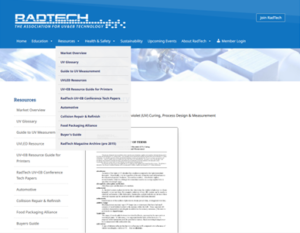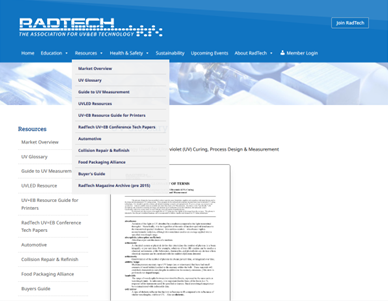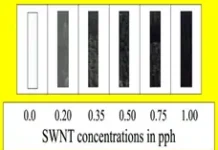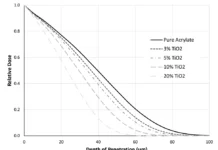While the title of this column was inspired by the 1981 movie Stripes, the idea for the column came from recent interactions with EIT customers, distributors and representatives at tradeshows, virtual meetings and visits. Reduced interactions during the pandemic and a welcome influx of new people to the industry have created a training gap in the level of UV knowledge, in my opinion.
The loss of UV knowledge mirrors losses in school-age students, as reported by the Harvard Magazine in a July 17, 2023, article by Ryan Doan-Nguyen: Math, reading and history scores from the past three years show that students experienced a significant decline in learning during the pandemic. The team’s calculations indicate that by the spring of 2022, the average student was lagging by approximately one-half year in math and one-third of a year in reading.
As we head into 2024, we need to focus on training – UV training. This could be a refresher for experienced employees or more extensive training for those new to UV. Opportunities for training include:
- New applications, creating first-time UV users.
- Many people are using UV for the first time in the form of UV LEDs, especially in the print industry.
- New employees are entering the industry to replace those who exited the work force or retired.
- Replacing knowledge lost from business mergers, reductions, acquisitions and consolidations.
I always have found the motivation to learn to be high in the UV industry. Training offers job security and the opportunity for career advancement.
There are a lot of very smart people in our industry, but they tend to exist and specialize in one specific UV area or ‘silo.’ Formulators need to understand more than the chemical makeup of their product. They need to understand how their product will be used and applied, along with UV source types, substrates, desired end properties, measurement basics and economic parameters needed. This ‘silo’ effect may have been exacerbated during the pandemic when working from home reduced the amount interaction and communication with colleagues, customers or technical resources. Cross-training to understand the different segments of the UV industry is important.
 Resources: Where Does Training Start?
Resources: Where Does Training Start?
- Trade Organizations and Publications: RadTech (www.radtech.org) and UV+EB Technology (www.uvebtech.com) have a lot of information available. As the American Express commercials used to say: “Membership has its Privileges.” RadTech members can access an extensive archive of webinars hosted exclusively in the ‘members only’ section of the RadTech website. Access is granted to insights from industry thought leaders and advanced photopolymer concepts. Additionally, the member resources encompass a wealth of technical papers from previous RadTech conferences and events, complemented by an array of EHS videos and regulatory briefings. Industry specific organizations, such as Printing United (www.printing.org) and others, also offer a ‘members only’ educational resource section.
- Tradeshows and Conferences: Are you coming to the RadTech Conference (https://radtech.org/radtech24/) this May in Orlando? Or to the Photopolymerization Fundamentals event in Colorado this fall?
- Company Websites: Most companies in the UV industry, whether supplying equipment or formulations, post both educational and technical information on their websites. This can include topics such as understanding the mechanism of UV photopolymerization, types of photoinitiators and potential applications.
- Technical and Sales Reps: This resource often is overlooked and can save both time and money. Chances are the rep has been involved in a similar application and can offer real-world experience and feedback.
Create a “Lunch and Learn”
In the summer of 2023, we started “lunch and learn” training for our team members. A short, focused session is held every three to four weeks on a specific topic. At EIT, we naturally spend more time on UV measurement, while a formulator would spend more time on chemistry. We plan to roll this program (EIT 2.0 UniVersity) out to our sales partners in 2024. An overview of the modules and topics we cover is listed below. Adjust the training to your specific needs and audience by changing the order of the modules or adding/deleting topics.
Module One: UV Technology Overview
Instead of starting with technical terms and acronyms, this module is meant to show how UV impacts our everyday lives. Review your customer list, and point out the items that your customers manufacture with UV. Examples: I see you have a cell phone. Did you use your computer today to access the internet? I see we are standing on flooring that was UV cured. Did you drive here? Do you wear glasses or contacts? What are you drinking? Look at the clarity of that image on the TV.
Explain how UV technology works and compare it to other technologies.
Remind your team that everyone is in sales. When someone asks, “What do you do for a living?,” this is a great opening to explain UV technology, how your company fits into the process and offer examples of how UV technology impacts the person who asked the question. I usually start with an analogy of painting a wall and how UV technology differs from that application.
Module Two: Speaking the Language, Terminology
- Terminology: Watts, Joules and how they are related
- UV spectrum: UV-A, UV-B, UV-C and UV-V and the importance of each band
- Other terminology that is important to your company
Module Three: UV Sources
- Type of UV sources: broadband, LED and advantages/disadvantages of each source type
- Typical spectral outputs of each source type
- Source components: power supply, cooling, settings, maintenance, safety-shielding
Module Four: UV Chemistry
- Components of typical formulation
- Advantages of UV chemistry and different types of reactions
- EHS, including preparation, handling and storage of UV chemistry
Module Five: Application Equipment
- Application technologies of UV materials
- Coordination between source, formulators and machine builders
- Maintenance of application equipment
Module Six: UV Process Window
- Establishing and maintaining a process window
- Review of different tools to help with quality
- Communication and procedures if outside of the process window
Module Seven: UV Measurement Tools
- Instrument types and importance of matching the instrument to the process/source
- Proper instrument use and settings
- Maintenance and calibration
Summary
“Do the best you can until you know better. Then when you know better, do better.” – Maya Angelou
UV training will help you to know better. Knowing better and doing better saves time and money!
Parting Thought
Where do bad rainbows go?
Prism. It’s a light sentence that gives them time to reflect.
 Jim Raymont
Jim Raymont
Director of Sales
EIT 2.0 LLC
jraymont@eit20.com






